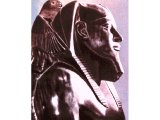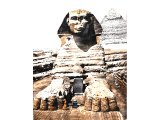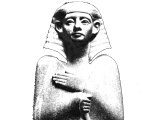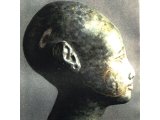
Amenhotep ii
If the Exodus took place about 1445 B.C., the Pharaoh was Amenhotep II. This cedar statuette representing him, shows him holding a lotus-ringed sceptre..
|

Chephren
This sphinx adjoins the pyramid of Chephren, King of Egypt and contained the dream tablet of Thothmes IV. On it is recorded a prophetic dream, which he had while sleeping in the shade of the sphinx.. He was told he would be king of Egypt, though he was not the eldest son of Amenhotep II (1461-1436 B.C.) who is thought by many to have been the Pharaoh of the Exodus. There is thus room for the explanation that the heir apparent was `the firstborn of Pharaoh` (Exodus xii, 29) slain by the tenth plague. An early photograph.
|

Chertiho
Sitting picture of Chertihotep, 12th Dynasty, c. 1900 B.C. Red-brown sandstone, in the gyptsches Museum, Berlin..
|

Princess
Small head of a princess, 18th Dynasty, c. 1370.
|